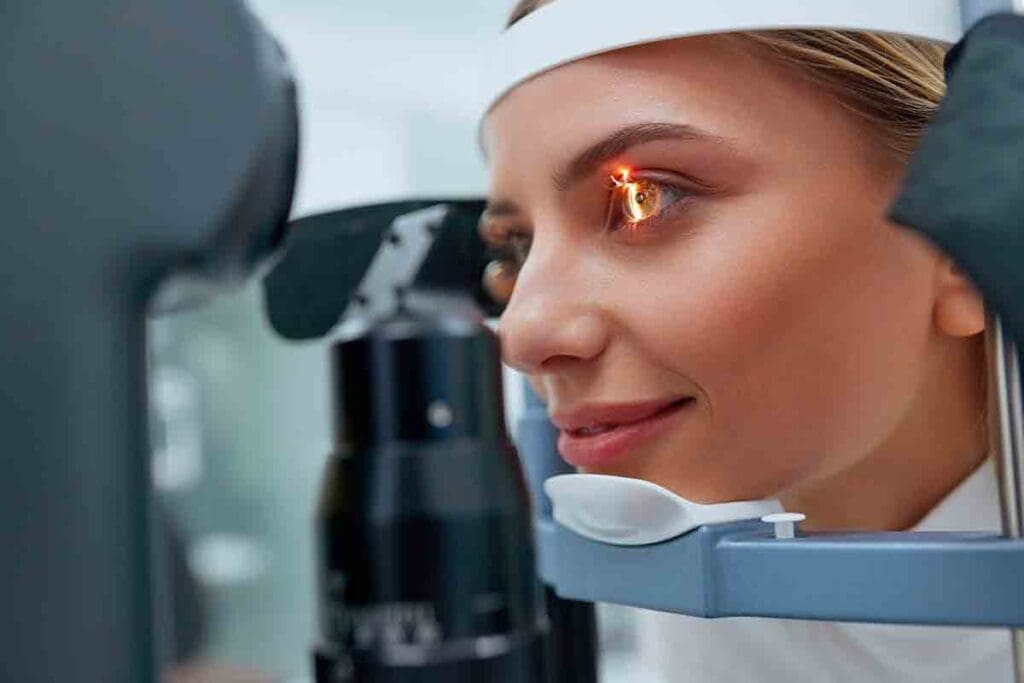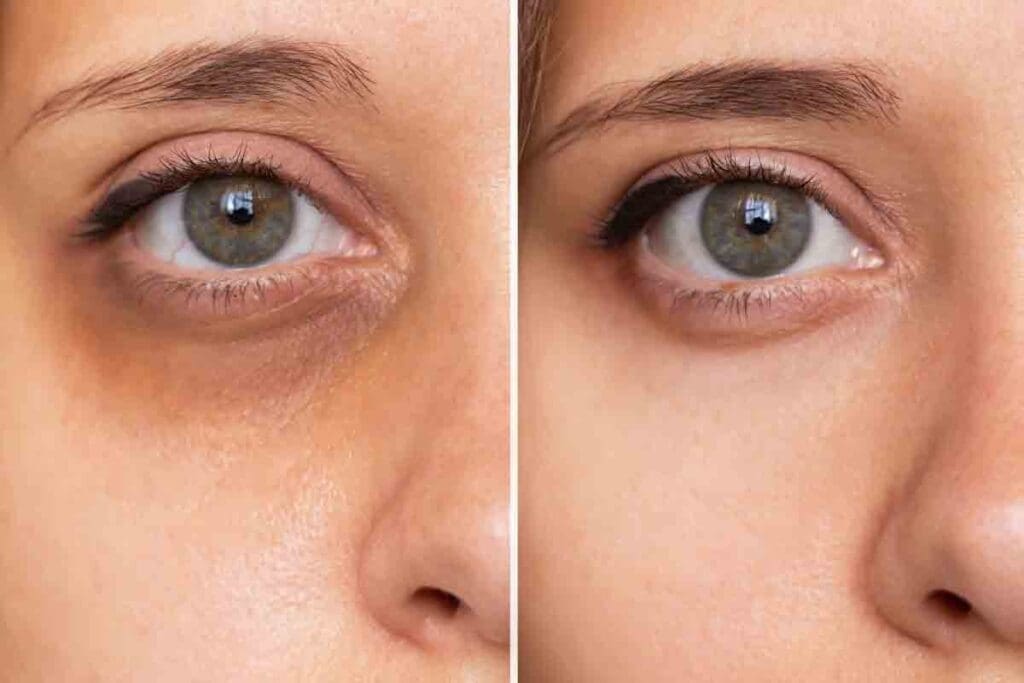Last Updated on November 14, 2025 by Ugurkan Demir

At Liv Hospital, we focus on advanced care for our patients. We pay close attention to signs of health problems, like iron deficiency anemia. Anemic eyes often look pale or washed out compared to normal eyes, which are vibrant red. This difference is because anemic eyes have less hemoglobin and iron.
Iron deficiency anemia can point to other health issues, like bleeding in the gut or heavy periods. It’s important to find and fix the main problem to avoid it coming back. By looking at the differences between anemic and normal eyes, we can spot health problems linked to iron deficiency anemia.

Eyes are like windows to our health, showing clues about how we’re doing. The color and condition of our eyelids can tell us a lot about our health.
Our eyes change when our body’s health does. For example, the color of the conjunctiva and inner eyelid can show our iron levels. Pale eyelids might mean we have low iron levels, which can lead to anemia. This makes our eyes important for checking our health.
Blood parts, like hemoglobin, are key to our eyes’ health. Hemoglobin carries oxygen to our body’s tissues, including our eyes. Adequate iron levels help make healthy hemoglobin, which keeps our eyelids looking good. Low iron can cause iron deficiency, changing our eyelid color and eye appearance.
Knowing how blood and eyes connect helps spot health problems early. A healthy eyelid color means good blood flow and oxygen. But pale eyelids can signal issues like anemia or iron deficiency.

Iron is key for healthy vision and eye looks. It helps red blood cells carry oxygen to the body, including the eyes. Low iron can cause eye problems.
Hemoglobin is in red blood cells and carries oxygen. It’s vital for eye health. Low hemoglobin means less oxygen for the eyes, causing symptoms.
The conjunctiva, covering the eyes, is very sensitive to hemoglobin changes. Iron deficiency can make it look pale or washed out.
| Hemoglobin Level | Effect on Eye Tissue |
| Normal | Healthy, vibrant appearance |
| Low | Pale or washed-out appearance |
Iron is key for hemoglobin to carry oxygen. Without enough iron, tissues, including the eyes, may not get enough oxygen.
This link between iron and oxygen is why iron deficiency affects the eyes. Keeping iron levels up ensures the eyes get the oxygen they need.
Key Points:
Comparing anemic eyes to normal eyes shows key differences. We’ll dive into these distinctions, focusing on appearance, signs, and what doctors check for in eye health.
Anemic eyes look pale or washed out compared to normal eyes. This is because of lower hemoglobin levels in the blood. Normal eyes, on the other hand, show a vibrant look, showing healthy blood flow and enough oxygen.
There are clear signs that set anemic eyes apart from normal ones. These include:
These signs are key for doctors to spot during checks.
Doctors check for specific signs of anemia or other health issues in the eyes. They look at the conjunctiva’s color, the eyes’ overall look, and other symptoms. By comparing anemic eyelids vs normal ones, doctors can understand a patient’s health better.
It’s vital to have a detailed check-up to correctly diagnose and treat anemic eye issues.
One key difference between anemic and normal eyes is the color of the conjunctiva and inner eyelid. The conjunctiva, a thin membrane, covers the white part of the eye. It plays a big role in showing overall health, helping to spot iron deficiency anemia.
In healthy people, the conjunctiva and inner eyelid are a vibrant red. This is because they have enough hemoglobin. Hemoglobin is made with iron and carries oxygen to the body’s tissues.
But people with iron deficiency anemia have a pale or washed-out look in these areas. This is because they have less hemoglobin. With less hemoglobin, less oxygen is carried, making them look pale.
The color changes in the conjunctiva and inner eyelid come from different hemoglobin levels. Hemoglobin needs iron to bind oxygen. When iron is enough iron, iron hemoglobin carries oxygen well, keeping these areas red. But with less iron, hemoglobin can’t carry as much oxygen, making them look pale.
| Characteristics | Normal Eyes | Anemic Eyes |
| Conjunctiva and Inner Eyelid Color | Vibrant red | Pale or washed-out |
| Hemoglobin Levels | Adequate | Reduced |
| Oxygen Transport | Effective | Impaired |
Knowing these differences is key for doctors and people looking for signs of iron deficiency anemia. Spotting the color changes in the conjunctiva and inner eyelid can help start the diagnosis and treatment process.
Blood flow and oxygen to the eyelid tissue are key to healthy eyes. Eyelids protect our eyes and show our health, mainly through blood flow.
People with normal iron and healthy blood flow have well-oxygenated eyelids. This makes them look vibrant and work well. Normal blood circulation patterns keep eyelid tissues oxygen-rich, supporting eye health.
Iron deficiency anemia leads to less blood flow and oxygen to the eyelids. This makes eyelids look pale or washed out, a sign of anemia. Less oxygen harms eyelid health and function.
Less blood flow and oxygen hurt eye health a lot. It causes eye fatigue, dryness, and irritation. Eye health depends on good circulation and oxygen delivery. So, treating iron deficiency and anemia is key to healthy eyes.
We know keeping blood flow and oxygen to our eyes is essential. By spotting anemia signs and acting on them, we help our eyes get the oxygen they need.
The eyelids are key when checking for anemia signs. They show different colors and looks, but some are normal, while others hint at iron issues.
Healthy eyelids are usually bright pink or red. This is because they get enough blood and oxygen. The normal eyelid color shows good health.
This color comes from hemoglobin in red blood cells. While most people have a uniform color, some might see slight differences.
But,nemic people often have pale eyelids. Their eyelids look washed out or pale pink. This is because they have less hemoglobin and oxygen.
Pale eyelids can be a clear sign of iron deficiency. Even without other symptoms, this can be a warning sign.
It’s important to remember that normal eyelid color can differ across cultures and ethnicities. While a bright red is usually seen as healthy, others might naturally have different eyelid colors.
For example, some ethnic groups might have more eyelid pigmentation. This can change how their eyelid color looks. Doctors need to know this to avoid mistakes.
Anemia affects the eyes in many ways. It can cause symptoms beyond just pale eyelids. We will look at these symptoms and what they mean.
Dark circles under the eyes are common in people with iron deficiency anemia. They are not just about looks. They can show health problems.
Poor oxygenation of the skin around the eyes can make it look darker. Dark circles can be caused by many things, but in anemia, they might be linked to iron deficiency.
Eyelid swelling is another sign of iron deficiency anemia. It happens because of fluid retention and poor circulation. Anemia makes it hard for the body to carry oxygen and keep tissues healthy, leading to swelling.
In some cases, eyelid swelling can also cause redness or irritation. It’s important to think about these symptoms and their connection to anemia.
Dark circles and eyelid swelling can be signs of anemia, but not only. Other things can cause these symptoms too. It’s key to figure out if it’s anemia or something else.
Doctors look at many things to diagnose eye area symptoms. They check medical history, diet, and lab results. For example, someone with dark circles and eyelid swelling might get blood tests for iron deficiency and anemia.
Understanding how anemia and its symptoms work together helps us manage health better.
Environmental conditions can change how we see symptoms of anemic eyes. This is important for spotting and handling anemia-related eye signs well.
Temperature can change how anemic eyes look. In cold, blood vessels get smaller, making anemia’s pale look more obvious. But, in warm weather, blood vessels get bigger, hiding some of the pale look. People with anemia might see their eye color change with temperature.
Lighting affects how we see anemic eye signs. Natural daylight shows eye color and pale besskin t. But, artificial light, like warm-toned, can hide anemia’s pallor. It’s good to check eyes in different lights to understand symptoms better.
Even with environmental changes, some signs of anemia stay the same. For example, the pale of the conjunctiva is often a sign of anemia, no matter the setting. Watching for these steady signs helps spot anemia. We suggest paying attention to these signs and getting medical help if eye changes keep happening.
Checking your eyelids is a simple way to spot iron deficiency anemia. This method involves a basic technique. It gives you insight into your iron levels.
To do the eyelid pull-down technique, gently pull down your lower eyelid. Look at the color of the inner lining. This area is full of blood vessels. It can show your iron levels.
A healthy inner eyelid is bright red because of enough hemoglobin. An anemic eyelid looks pale or washed out.
| Characteristics | Healthy Eyelid | Anemic Eyelid |
| Color | Vibrant Red | Pale or Washed Out |
| Hemoglobin Level | Normal | Low |
| Indication | Good Iron Levels | Potential Iron Deficiency |
If your inner eyelid is always pale or washed out, it could mean iron deficiency anemia. Seeing a healthcare professional for a diagnosis and treatment is key.
Key Takeaways:
Iron deficiency can show up in unexpected ways, even without anemia. Many know iron deficiency can lead to anemia. But there are other signs that show iron levels might be off.
Let’s look at some unusual signs that might mean you have an iron deficiency, even if your blood tests look fine.
Restless Legs Syndrome (RLS) is a strange sign of iron deficiency. It makes you feel like you must move your legs, often with uncomfortable feelings. Studies link low iron to RLS.
Why does this happen? Iron helps make dopamine, which controls movement. Without enough iron, dopamine production might be off, causing RLS.
Iron deficiency can harm your nails and hair. Brittle nails and hair loss might mean you’re low on iron. Iron is key for making hemoglobin, which carries oxygen to cells, including those in your nails and hair follicles.
Without enough iron, these cells might not get enough oxygen, leading to brittle nails and hair loss.
Some with iron deficiency have pica, a craving for non-food items like dirt or chalk. The exact reason for pica is unknown, but it’s thought that the body is looking for minerals, including iron.
Even with normal blood tests, pale eyelid mucosa can signal iron deficiency. The conjunctiva, the membrane covering your eyes’ white part, looks pale when iron is low.
Checking your eyelid mucosa is a simple way to spot iron deficiency signs. Pull down your lower eyelid and look at the color. A healthy conjunctiva is a vibrant red.
If you notice these unusual symptoms, talk to your healthcare provider. They can figure out if iron deficiency is the cause and suggest treatment.
Fixing anemic eye symptoms needs a mix of diet changes and sometimes medicine. By tackling the root cause of anemia, we can make the eye symptoms better.
To treat anemic eye symptoms, boosting iron levels is key. Eating foods rich in iron is a good start. Iron-rich foods are divided into two groups: animal products like meat, poultry, and fish, and plant-based foods like beans, lentils, and cereals.
| Food Type | Examples | Iron Content |
| Heme Iron | Red meat, poultry, fish | Highly bioavailable |
| Non-Heme Iron | Beans, lentils, fortified cereals | Less bioavailable; enhanced absorption with Vitamin C |
Some foods and drinks can block iron absorption. For example, coffee and tea can lower iron absorption. It’s best to drink them between meals, not with iron-rich foods.
Sometimes, just eating right isn’t enough to fix iron deficiency anemia. Iron supplements can fill the gap. But, they should only be taken with a doctor’s advice to avoid too much and side effects.
“Iron supplementation is a common treatment for iron deficiency anemia, but it must be used judiciously to avoid complications.”
Medical Guidelines
Doctors might also need to treat the cause of anemia, like bleeding or poor absorption. Fixing these problems is key to managing anemic eye symptoms.
How fast you see improvement in anemic eye symptoms depends on the severity and the treatment success. Usually, you can see eye improvements in a few months as iron levels rise and anemia is fixed.
It’s vital to keep in touch with your doctor to track your progress and adjust your treatment if needed. Regular check-ups ensure your iron levels are going up and your eye symptoms are getting better.
It’s important to know the difference between anemic eyes and normal eyes. This helps spot health issues linked to iron deficiency. We’ve looked at how anemic eyes, with pale or washed-out eyelids, are different from healthy eyes with vibrant red conjunctiva.
Iron deficiency anemia can really affect eye health. Knowing this is key to staying healthy. By noticing signs like changes in eyelid color and symptoms like dark circles or swelling, people can get help early.
To keep eyelids healthy, we need to focus on diet, supplements, and sometimes medical help. We urge readers to take care of their health. Understanding healthy eyelid color is key, as it shows overall health. This is true, even when dealing with iron deficiency eyelids and comparing anemic eyes vs normal eyes.
Anemic eyes look pale or washed out because of low iron. Normal eyes are vibrant red. Look at the conjunctiva and inner eyelids to see these differences.
Iron deficiency lowers hemoglobin levels. This affects oxygen to the eye tissues. It can make eyelids pale or discolored.
Healthy eyelids are vibrant red due to good blood flow and oxygen. Color can vary slightly among people because of cultural and ethnic differences.
Yes, anemia can lead to dark circles under the eyes. Low iron and poor oxygenation make the skin appear darker or discolored.
Use the eyelid pull-down technique to check your inner eyelids. Healthy tissue should be vibrant red. Anemic tissue looks pale or washed out.
Yes, signs include restless legs, brittle nails and hair loss, unusual cravings (pica), and pale eyelid mucosa despite normal blood tests.
Eating iron-rich foods and taking supplements can help. Sometimes, medical treatment is needed, too.
Improvement time varies with iron deficiency severity and treatment success. Generally, you’ll see changes in a few weeks to months.
Yes, temperature, lighting, and other environmental factors can change how anemic eye symptoms appear.
If symptoms like pale or discolored eyelids, dark circles, or other eye issues persist or worsen, see a healthcare professional for evaluation and treatment.
Subscribe to our e-newsletter to stay informed about the latest innovations in the world of health and exclusive offers!